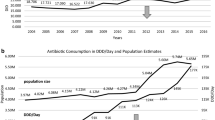Abstract
Faster spread of epidemics has turned local concerns into global crises; antimicrobial resistance (AMR) is being considered a major threat to public health in the twenty-first century. Antibiotic misuse plays a great role in accelerated AMR; thus, understanding and discussing consumption patterns has been a trend topic over the past years. Developing countries, such as Brazil, have high growth rates in antibiotic consumption, potentially impacting global environmental safety. This study presents the compiled information from the Brazilian Health Regulatory Agency (ANVISA) on antibiotic dispensation across the country and maps the consumption trends between the years of 2013 and 2016. The most consumed substances were beta-lactams (amoxicillin and cephalexin) and macrolides (azithromycin). National relative growth consumption in the mentioned period was 18%. At the local level, growth of consumption ranged from 4 to 85%, with rampage growth concentrated in the North and Northeast regions. Brazilian laws, such as restriction of over-the-counter sales and mandatory report on dispensation, seem to have little effect on the national antibiotic consumption growth. This phenomenon growth is still elevated if compared with developed countries, demonstrating the need for further surveillance as well as coordinated efforts aiming at antibiotic use and AMR prevention.







Similar content being viewed by others
References
Aminov RI (2010) A brief history of the antibiotic era: lessons learned and challenges for the future. Front Microbiol 1:1–7. https://doi.org/10.3389/fmicb.2010.00134
ANVISA. (2010). Resolução Da Diretoria Colegiada - RDC No 44 de 26 de Outubro de 2010, 4. http://bvsms.saude.gov.br/bvs/saudelegis/anvisa/2010/res0044_26_10_2010.html
ANVISA. (2011). Resolução de Diretoria Colegiada - RDC No 20 de Maio de 2011, 9. https://doi.org/10.1017/CBO9781107415324.004
Bebell LM, Muiru AN (2014) Antibiotic use and emerging resistance: how can resource-limited countries turn the tide? Glob Heart 9(3):347–358. https://doi.org/10.1016/j.gheart.2014.08.009
Van Boeckel TP, Gandra S, Ashok A, Caudron Q, Grenfell BT, Levin SA, Laxminarayan R (2014) Global antibiotic consumption 2000 to 2010: an analysis of national pharmaceutical sales data. Lancet Infect Dis 14(8):742–750. https://doi.org/10.1016/S1473-3099(14)70780-7
Brasil (2012). Uso Racional de Medicamentos: Temas Selecionados. Edited by Secretaria de Ciência Tecnologia e Insumos Estratégicos. Ministério Da Saúde. Série A. N. Brasília: Ministério da Saúde
Brown ED, Wright GD (2016) Antibacterial drug discovery in the resistance era. Nature 529(7586):336–343. https://doi.org/10.1038/nature17042
Carias CM, Vieira FS, Giordano CV, Zucchi P (2011) Medicamentos de Dispensação Excepcional: Histórico e Gastos Do Ministério Da Saúde Do Brasil. Revista de Saude Publica 45(2):233–240. https://doi.org/10.1590/S0034-89102011000200001
Carvalho IT, Santos L (2016) Antibiotics in the aquatic environments: a review of the European scenario. Environ Int 94:736–757. https://doi.org/10.1016/j.envint.2016.06.025
Davies J, Davies D (2010) Origins and evolution of antibiotic resistance. Microbiol Mol Biol Rev 74(3):417–433. https://doi.org/10.1128/MMBR.00016-10
Garcia MM, Júnior AAG, de Assis Acúrcio F (2017) Avaliação Econômica Dos Programas Rede Farmácia de Minas Do SUS versus Farmácia Popular Do Brasil. Ciência & Saúde Coletiva 22(1):221–233. https://doi.org/10.1590/1413-81232017221.15912015
Gross M (2013) Antibiotics in crisis. Curr Biol 23(24):R1063–R1065. https://doi.org/10.1016/j.cub.2013.11.057
IBGE (2017) Geociências - IBGE :: Instituto Brasileiro de Geografia e Estatística. 2017. https://ww2.ibge.gov.br/home/geociencias/cartografia/default.shtm
Levy SB, Marshall B (2004) Antibacterial resistance worldwide: causes, challenges and responses. Nat Med 10(12s):S122–S129. https://doi.org/10.1038/nm1145
Moura ML, Boszczowski I, Mortari N, Barrozo LV, Neto FC, Lobo RD, de Lima ACP, Levin AS (2015) The impact of restricting over-the-counter sales of antimicrobial drugs. Medicine 94(38):e1605. https://doi.org/10.1097/MD.0000000000001605
Paphitou NI (2013) Antimicrobial resistance: action to combat the rising microbial challenges. Int J Antimicrob Agents 42(SUPPL.1):S25–S28. https://doi.org/10.1016/j.ijantimicag.2013.04.007
PNUD, Ipea, FJP (2013) Índice de Desenvolvimento Humano Municipal Brasileiro. Atlas Do Desenvolvimento Humano No Brasil, Brasília
Roraima (2016). Diário Oficial - Etado de Roraima No 2897 - 06 de Dezembro de 2016. Diário Oficial - Etado de Roraima, no. 2897: 44. http://imprensaoficial.hospedagemdesites.ws/diarios/doe-20161206.pdf
Santos-Pinto CDB, do Rosário Costa N, Osorio-de-Castro CGS (2011) Quem Acessa o Programa Farmácia Popular Do Brasil? Aspectos Do Fornecimento Público de Medicamentos. Cien Saude Colet 16(6):2963–2973. https://doi.org/10.1590/S1413-81232011000600034
Szekeres E, Baricz A, Chiriac CM, Farkas A, Opris O, Soran ML, Andrei AS et al (2017) Abundance of antibiotics, antibiotic resistance genes and bacterial community composition in wastewater effluents from different Romanian hospitals. Environ Pollut 225:304–315. https://doi.org/10.1016/j.envpol.2017.01.054
United Nations Development Programme (2014) Sustaining human progress: reducing vulnerabilities and building resilience. Hum Dev Rep 2014. https://doi.org/ISBN:978-92-1-126340-4
WHO (2014a) Antimicrobial resistance: global report on surveillance. World Health Organization. https://doi.org/1.4.2014
WHO (2014b) Antimicrobial resistance. Bull World Health Organ 61(3):383–394. https://doi.org/10.1007/s13312-014-0374-3
Wise R, Hart T, Cars O, Streulens M, Helmuth R, Huovinen P, Sprenger M (1998) Antimicrobial resistance. Is a major threat to public health. Bmj 317(7159):609–610. https://doi.org/10.1136/bmj.317.7159.609
Acknowledgments
We thank ANVISA for the concession of the data used in this research. Also the Federal University of Ouro Preto (UFOP), the Coordination of Improvement of Higher Level Personnel (CAPES), the Brazilian National Council for Scientific and Technological Development (CNPq), the Foundation of Support Research of the State of Minas Gerais (FAPEMIG), and the Funding Authority for Studies and Projects (FINEP) for the structure to support the research and the authors. We thank the Environmental Engineering Graduate Program of UFOP (ProAmb - UFOP) and the Minas Gerais’ Multicenter Graduate Program on Chemistry (PPGMQ-MG) to which the authors are members.
Funding
Support for the research and the authors were provided by the Federal University of Ouro Preto (UFOP), the Coordination of Improvement of Higher Level Personnel (CAPES), the Brazilian National Council for Scientific and Technological Development (CNPq), the Foundation of Support Research of the State of Minas Gerais (FAPEMIG), and the Funding Authority for Studies and Projects (FINEP).
Author information
Authors and Affiliations
Corresponding author
Additional information
Responsible editor: Philippe Garrigues
Publisher’s note
Springer Nature remains neutral with regard to jurisdictional claims in published maps and institutional affiliations.
Electronic supplementary material
ESM 1
(DOCX 58 kb)
Rights and permissions
About this article
Cite this article
Neves e Castro, P.B., da Silva Rodrigues, D.A., Roeser, H.M.P. et al. Antibiotic consumption in developing countries defies global commitments: an overview on Brazilian growth in consumption. Environ Sci Pollut Res 27, 21013–21020 (2020). https://doi.org/10.1007/s11356-020-08574-x
Received:
Accepted:
Published:
Issue Date:
DOI: https://doi.org/10.1007/s11356-020-08574-x




